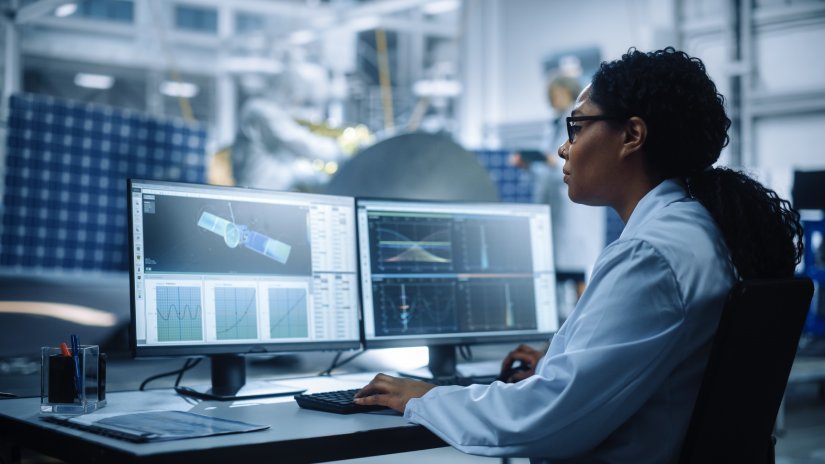The Significance of Bilateral Collaboration in Aerospace R&D
25th Sep 2023“Science is a collaborative effort.” As American Physicist and Electrical Engineer John Bardeen famously stated. “The combined results of several people working together are often much more effective than that of an individual scientist working alone.” The ideology holds true throughout all STEM-related professions, especially in the aerospace bracket. In this blog, we delve into the joint ventures within this domain, covering bilateral alliances, and explore how they contribute to further achievements.

At Knight Optical, we understand the transformative power of knowledge sharing and the enriching influence of diverse perspectives in our fast-evolving world. Our work takes us across a wide spectrum of industries, from the revolutionary spheres of aerospace and defence (A&D) to the precision-driven territories of med tech, the dynamic worlds of oil and gas, the captivating domains of entertainment, and even the uncharted depths of the subsea division.
In these wide-ranging landscapes, our customers recognise and celebrate the vital role of partnerships. However, one sector stands out as a pioneer in encouraging collaborative endeavours – the aviation field.
The Global Space Sector
 Worldwide, notable milestones are underway in the realms of space exploration, technology, and science. While much attention is directed toward NASA, space agencies from different nations are making remarkable strides, expanding the horizons of human achievement. This represents not only the pinnacle of technological growth but also an arena where the saying “the sky’s the limit” takes on a whole new dimension.
Worldwide, notable milestones are underway in the realms of space exploration, technology, and science. While much attention is directed toward NASA, space agencies from different nations are making remarkable strides, expanding the horizons of human achievement. This represents not only the pinnacle of technological growth but also an arena where the saying “the sky’s the limit” takes on a whole new dimension.
For instance, as part of NASA’s Artemis moon missions, the Australian Space Agency has aspiring strategies to deploy its inaugural robotic rover in 2026 for the purpose of gathering lunar soil [1]. In a characteristic Aussie fashion that welcomes a sense of fun, residents of the country have the opportunity to participate in a competition to name the moon-exploring vehicle!
Meanwhile, here in the UK, there are discussions about revitalising satellite projects. Following the country’s cancelled launch event in 1971, known as Black Arrow, which took place at the Woomera rocket range in South Australia, numerous businesses are now competing for prospects to launch rockets from British territory.
What’s more, there are plans for multiple launches from various firms within the UK. In a recent conversation with The Guardian, Euan Clark, a Project Team Lead at Skyrora – one of the companies striving to secure these possibilities of launching on British soil – said: “Our goal is to achieve a monthly rocket launch within the next few years [2].”
The Skills Shortage
 Although the nation appears poised for economic prosperity and ambitious pursuits, a pervasive issue persists, with STEM fields bearing the brunt of its impact. As per the findings outlined in the ‘Space Sector Skills Survey 2023’ – jointly conducted by the UK Space Agency (UKSA) and the Department for Science, Innovation, and Technology (DSIT) – a significant 97% of organisations within the UK’s space sector are experiencing talent deficiencies and reporting adverse effects on their business performance and growth [3].
Although the nation appears poised for economic prosperity and ambitious pursuits, a pervasive issue persists, with STEM fields bearing the brunt of its impact. As per the findings outlined in the ‘Space Sector Skills Survey 2023’ – jointly conducted by the UK Space Agency (UKSA) and the Department for Science, Innovation, and Technology (DSIT) – a significant 97% of organisations within the UK’s space sector are experiencing talent deficiencies and reporting adverse effects on their business performance and growth [3].
The survey underscores a critical concern: the provision of competent and seasoned professionals is failing to keep pace with the industry’s rapid expansion. Doug Liddle, Chair of the Space Skills Advisory Panel, emphatically articulated: “The sector’s capacity to innovate, scale up, and deliver cutting-edge solutions to contemporary challenges is hindered by the limited access to the diverse skill sets necessary to confront these obstacles [3].”
Down under, the situation bears a resemblance to the UK, as reports indicate that it, too, is grappling with growing pains.
Forming an Alliance
A productive tactic for tackling the difficulties posed by skill shortages involves engaging in bilateral collaboration. This method not only addresses labour shortcomings but also possesses the potential to expedite improvements, lower expenses, and enhance the standard of R&D undertakings.
In fact, the two nations under discussion have already adopted this approach. They have joined forces in the form of the ‘Space Bridge’ partnership, a concerted effort targeted at promoting information sharing and boosting investments within their respective space sectors to tackle shared issues head-on.
The UK-Aus Space Bridge
 In 2021, Australia and the UK forged a groundbreaking Space Bridge agreement, marking a pioneering step towards accessing enhanced openings in trade, investment, academic research, and nurturing innovative bilateral collaborations. Since then, researchers have introduced a valuable resource recognised as the UK Space Capabilities Catalogue (UKSCC), directed at facilitating the entry of Australian space companies into the UK marketplace and providing Governments with insights into areas where gaps could be addressed [4].
In 2021, Australia and the UK forged a groundbreaking Space Bridge agreement, marking a pioneering step towards accessing enhanced openings in trade, investment, academic research, and nurturing innovative bilateral collaborations. Since then, researchers have introduced a valuable resource recognised as the UK Space Capabilities Catalogue (UKSCC), directed at facilitating the entry of Australian space companies into the UK marketplace and providing Governments with insights into areas where gaps could be addressed [4].
Moreover, the UK Government’s policy paper from July 2023, titled ‘National Space Strategy in Action,’ highlights two key outcomes arising from the Space Bridge. The first funding call under the scheme allocated a total of £250,000 to support five collaborative research ventures. Additionally, a substantial commitment of £1m was announced by UKRI for Earth Observation in AgroClimate, aimed at assisting farmers in mitigating the impacts of climate change [5].
The paper also outlines upcoming plans, including the continuation of efforts to identify priority international partners for future collaborations, fostering deeper mutual connections, and addressing universal concerns in the field of space. Furthermore, it emphasises the intention to strengthen relationships with countries, like the Joint Committee for Science, Technology, and Innovation, as established during the Anglo-French summit in March 2023 [5].
Unlocking Horizons
In summary, bilateral collaboration, particularly in the field of Aerospace & Defence is undeniably pivotal in propelling the market’s advancements. As we’ve witnessed through initiatives like the ‘Space Bridge’ between the UK and Australia, such unions open doors to a world of opportunities. They foster not only trade, investment, and academic research but also the invaluable exchange of proficiency and expertise.
Bilateral collaboration also takes on the pressing challenge of skill shortages, enabling accelerated progress, cost efficiency, and heightened R&D quality. It’s a testament to the enduring principle that in science and innovation, collaboration is the key to revealing new frontiers.
As the aerospace industry continues to soar to new heights, these collaborations serve as the launchpad for breakthroughs, ensuring that, together, we can push the boundaries.
FOOTNOTES:
[1] https://www.space.com/australia-moon-rover-2026-nasa-artemis
[3] https://www.digit.fyi/uks-space-sector-being-throttled-by-ongoing-skills-gap-report-finds/
[4] https://cosmosmagazine.com/space/supply-chain-australia-uk-space-bridge/